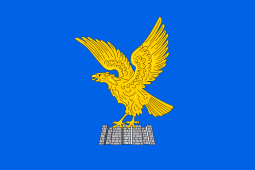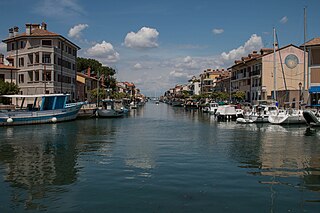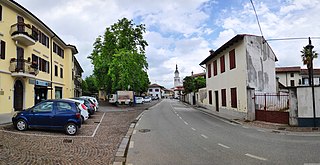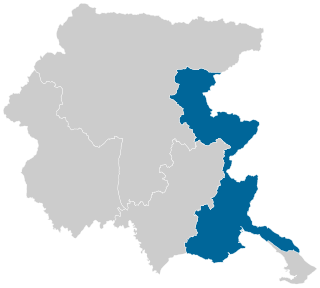 | |
| Use | Civil and state flag |
|---|---|
| Proportion | 3:2 |
| Adopted | 17 October 2001 |
The flag of Friuli-Venezia Giulia [lower-alpha 1] depicts a golden eagle facing to its right standing on white fortifications on a blue background.
 | |
| Use | Civil and state flag |
|---|---|
| Proportion | 3:2 |
| Adopted | 17 October 2001 |
The flag of Friuli-Venezia Giulia [lower-alpha 1] depicts a golden eagle facing to its right standing on white fortifications on a blue background.
The colours (gold and blue) originate from the historic flag of Friuli used by the medieval Patria del Friuli – a state that was independent from 1077 to 1420 and ruled by the Patriarchate of Aquileia. The symbols of the eagle comes from the name of the ancient city of Aquileia, which, according to popular legend, derived from an eagle (Latin : aquila) who showed the first citizens the spot where the ancient city should be founded.
The modern flag, adopted in 2001, uses an eagle design found on an antique vase kept in a museum in Aquileia. [1]

Friuli-Venezia Giulia is one of the 20 regions of Italy and one of five autonomous regions with special statute. The regional capital is Trieste on the Gulf of Trieste, a bay of the Adriatic Sea.

Friuli is a historical region of northeast Italy. The region is marked by its separate regional and ethnic identity predominantly tied to the Friulians, who speak the Friulian language. It comprises the major part of the autonomous region Friuli-Venezia Giulia, i.e. the administrative provinces of Udine, Pordenone, and Gorizia, excluding Trieste.

Northeast Italy is one of the five official statistical regions of Italy used by the National Institute of Statistics (ISTAT), a first level NUTS region and a European Parliament constituency. Northeast encompasses four of the country's 20 regions:

The province of Trieste is a province in the autonomous Friuli-Venezia Giulia region of Italy. Its capital was the city of Trieste. It had an area of 212 square kilometres (82 sq mi) and it had a total population of 234,668. It had a coastal length of 48.1 kilometres (29.9 mi). Abolished in 2017, it was reestablished in 2019 as the regional decentralization entity of Trieste, and was reactivated on 1 July 2020.

The province of Udine was a province in the autonomous Friuli-Venezia Giulia region of Italy, bordering Austria and Slovenia, with the capital in the city of Udine. Abolished on 30 September 2017, it was reestablished in 2019 as the Regional Decentralization Entity of Udine, and was reactivated on 1 July 2020. It has a population of 530,849 inhabitants over an area of 4,907.24 square kilometres (1,894.70 sq mi).

The Julian March, also called Julian Venetia, is an area of southern Central Europe which is currently divided among Croatia, Italy, and Slovenia. The term was coined in 1863 by the Italian linguist Graziadio Isaia Ascoli, a native of the area, to demonstrate that the Austrian Littoral, Veneto, Friuli, and Trentino shared a common Italian linguistic identity. Ascoli emphasized the Augustan partition of Roman Italy at the beginning of the Empire, when Venetia et Histria was Regio X.

Grado is a town and comune (municipality) of 8,064 residents in the Regional decentralization entity of Gorizia in the north-eastern Italian region of Friuli-Venezia Giulia, located on an island and adjacent peninsula of the Adriatic Sea between Venice and Trieste. The territory of the municipality of Grado extends between the mouth of the Isonzo and the Adriatic Sea and the Grado Lagoon, and covers an area of about 90 square kilometers between Porto Buso and Fossalon. Characteristic of the lagoon is the presence of the casoni, which are simple houses with thatched roof used in the past by the fishermen of Grado, who remained in the lagoon for a long time, returning to the island of Grado only during the colder period of the year.

Monfalcone is a town and comune (municipality) in the Regional decentralization entity of Gorizia in Friuli-Venezia Giulia, northern Italy, located on the Gulf of Trieste. Its name means 'falcon mountain'.

The flag of Friuli is the official standard of historical Friuli. A Friuli-Venezia Giulia Autonomous Regional law describes the flag as consisting of "…a rectangular standard featuring at its centre a golden heraldic eagle with outspread wings, headturned to the left, open beak and red claws, set in a sky blue field. The crest covers three fifths of the height of the flag, which in turn is two thirds of its length."

The Slovene Littoral, or simply Littoral, is one of the traditional regions of Slovenia. The littoral in its name – for a coastal-adjacent area – recalls the former Austrian Littoral, the Habsburg possessions on the upper Adriatic coast, of which the Slovene Littoral was part. Today, the Littoral is often associated with the Slovenian ethnic territory that, in the first half of the 20th century, found itself in Italy to the west of the Rapallo Border, which separated a quarter of Slovenes from the rest of the nation, and was strongly influenced by Italian fascism.

The Triveneto or Tre Venezie, also often referred to as North-Eastern Italy or simply North-East, is a historical region of Italy. The area is made up of the three smaller historical regions of Venezia Euganea, Venezia Giulia and Venezia Tridentina. This territory was named after the Roman region of Venetia et Histria.

Cervignano del Friuli is a comune (municipality) in the Regional decentralization entity of Udine, in Friuli-Venezia Giulia, Italy. It is the most important town of Bassa Friulana. It lies at about 12 kilometres (7 mi) from the Laguna di Grado and at about 18 kilometres (11 mi) from the Adriatic Sea; from the point of view of viability, its position is peculiar since it lies at the junction of the SS14, linking Venice to Trieste, and the SS352, linking Udine to Grado. Nevertheless, it is in Cervignano that the railroad from Austria, passing through Tarvisio and Udine, ends, and is linked to the one from Venice to Trieste. Its frazione (borough) of Strassoldo is one of I Borghi più belli d'Italia.
Campolongo al Torre is a former comune of the Province of Udine in the Italian region Friuli-Venezia Giulia, located about 40 km northwest of Trieste and about 25 km southeast of Udine. Since 2009 it has been one of the two principal centres of Campolongo Tapogliano, a municipality formed by its merger with the former comune of Tapogliano.

Venzone is a comune (municipality) in the Regional decentralization entity of Udine in the Italian region of Friuli-Venezia Giulia. It is one of I Borghi più belli d'Italia.

Capriva del Friuli is a comune (municipality) in the Regional decentralization entity of Gorizia in the Italian region of Friuli-Venezia Giulia, located about 40 kilometres (25 mi) northwest of Trieste and about 8 kilometres (5 mi) west of Gorizia.

The Slovene Union is a political party in Italy representing the Slovene minority in the Friuli-Venezia Giulia region. Its Slovene name means literally "Slovene Community", but the denomination "Slovene Union" is used in other languages.
Slovene minority in Italy, also known as Slovenes in Italy is the name given to Italian citizens who belong to the autochthonous Slovene ethnic and linguistic minority living in the Italian autonomous region of Friuli-Venezia Giulia. The vast majority of members of the Slovene ethnic minority live in the Provinces of Trieste, Gorizia, and Udine. Estimates of their number vary significantly; the official figures show 52,194 Slovenian speakers in Friuli-Venezia Giulia, as per the 1971 census, but Slovenian estimates speak of 83,000 to 100,000 people.
Cassa di Risparmio del Friuli Venezia Giulia S.p.A., known as CariFVG in short, was an Italian savings bank based in Gorizia, Friuli – Venezia Giulia region.

The composition in the Friulian language entitled Incuintri al doman, written by Renato Stroili Gurisatti and set to music by maestro Valter Sivilotti in 2017, is the official anthem of Friuli.

The Gorizia electoral district was an uninominal district in Italy for the Chamber of Deputies.